An Overview of Underwater Connectors
Abstract
:1. Introduction
2. Background and Functional Units
2.1. Characteristics, Classfication and Terminologies
2.2. History
2.3. Main Available COTS Connectors
2.4. Functional Units
- (1)
- Connecting Unit provides the reliable and stable transmission of electricity or optical signal (or both) between plug and receptacle connectors with the desired specifications, when underwater connectors are in the mating state. The connecting unit is the primary functional unit, whose design is demanded not only to guarantee the stability and security of connections but also to reduce power loss on contact interfaces as much as possible.
- (2)
- Sealing Unit can provide enough water sealing performance for the underwater connectors. The sealing unit could be the most important functional unit, which should maintain a clean, stable and safe environment to the connecting unit. The sealing unit should prevent seawater, sediment, grit and any other contaminants from entering the interior of connectors, and prevent the oil leakage of PBOF connectors as well.
- (3)
- Pressure-Balanced (or Pressure-Compensated) Unit can produce an internal pressure to balance the ambient pressure automatically, reduce or even eliminate the differential pressure between the internal and the external of underwater connectors. An excellent pressure-balanced unit should have good reliability and sensitivity.
- (4)
- Aligning Unit aligns the electrical and optical connection to improve the quality of connection by its mechanical structure. It is an important functional unit to realize low power loss of underwater connectors, especially for optical connectors.
- (5)
- Locking Unit locks plug and receptacle connectors to improve reliability, stability and quality of connection after mating. The locking unit should be flexible to mate or de-mate the connectors.
3. Connecting Unit
3.1. Contact Resistance
3.2. Electrical Insulation
3.3. Coupling of Fiber-to-Fiber
- (1)
- The introduction of optical elements could not be affected by the offset and the end-gap between the end-faces of two optical fibers;
- (2)
- (3)
- The expanded-beam connectors are convenient for cleaning and assembling, and even easier for the integration of optical processing elements to achieve wavelength-division multiplexing, beam-splitting, switching and so on [55].
3.4. Insertion Loss
3.5. Return Loss
4. Sealing Unit and Pressure-Balanced Unit
4.1. Sealing Unit
4.2. PBOF Technology
4.3. Penetrable Self-Sealing
5. Aligning Unit and Locking Unit
6. Discussions and Conclusions
6.1. Discussions
6.2. Conclusions
Author Contributions
Funding
Institutional Review Board Statement
Informed Consent Statement
Data Availability Statement
Acknowledgments
Conflicts of Interest
References
- Trujillo, A.P.; Thurman, H.V. Essentials of Oceanography, 12th ed.; Pearson: Boston, MA, USA, 2017; pp. 3–38. ISBN 978-013-407-354-5. [Google Scholar]
- How Much of the Ocean Have We Explored? Available online: https://oceanservice.noaa.gov/facts/exploration.html (accessed on 19 July 2021).
- Garrison, T.; Ellis, R. Oceanography—An Invitation to Marine Science, 9th ed.; Cengage Learning: Boston, MA, USA, 2016; pp. 165–196. ISBN 978-130-525-428-2. [Google Scholar]
- Song, W.T.; Cui, W.C. Review of deep-ocean high-pressure simulation systems. Mar. Technol. Soc. J. 2020, 54, 68–84. [Google Scholar] [CrossRef]
- Cui, W.C.; Guo, W.; Wang, F.; Jiang, Z.; Luo, G.S.; Pan, B.B. Technologies and Applications of Submersibles; Shanghai Scientific & Technical Publishers: Shanghai, China, 2018; pp. 1–12. ISBN 978-754-784-173-0. [Google Scholar]
- Cui, W.C.; Hu, Y.; Guo, W.; Pan, B.B.; Wang, F. A preliminary design of a movable laboratory for hadal trenches. Methods Oceanogr. 2014, 9, 1–16. [Google Scholar] [CrossRef]
- Vedachalam, N.; Ramesh, R.; Jyothi, V.B.N.; Prakash, V.D.; Ramadass, G.A. Autonomous underwater vehicles: Challenging developments and technological maturity towards strategic swarm robotics systems. Mar. Georesources Geotechnol. 2019, 37, 525–538. [Google Scholar] [CrossRef]
- Teague, J.; Allen, M.J.; Scott, T.B. The potential of low-cost ROV for use in deep-sea mineral, ore prospecting and monitoring. Ocean. Eng. 2018, 147, 333–339. [Google Scholar] [CrossRef]
- Wynn, R.B.; Huvenne, V.A.I.; Le, B.T.P.; Murton, B.J.; Connelly, D.P.; Bett, B.J.; Ruhl, H.A.; Morris, K.J.; Peakall, J.; Parsons, D.R.; et al. Autonomous underwater vehicles (AUVs): Their past, present and future contributions to the advancement of marine geoscience. Mar. Geol. 2014, 352, 451–468. [Google Scholar] [CrossRef] [Green Version]
- Cui, W.C. An overview of submersible research and development in China. J. Mar. Sci. Appl. 2018, 17, 459–470. [Google Scholar] [CrossRef]
- Cui, W.C. Development of the Jiaolong deep manned submersible. Mar. Technol. Soc. J. 2013, 47, 37–54. [Google Scholar] [CrossRef]
- Kohnen, W. Human exploration of the deep seas: Fifty years and the inspiration continues. Mar. Technol. Soc. J. 2009, 43, 42–62. [Google Scholar] [CrossRef]
- Moorhouse, P. A modern history of the manned submersible. Mar. Technol. Soc. J. 2015, 49, 65–78. [Google Scholar] [CrossRef]
- Bowen, A.D.; Yoerger, D.R.; Whitcomb, L.L.; Fornari, D.J. Exploring the deepest depths: Preliminary design of a novel light-tethered hybrid ROV for global science in extreme environments. Mar. Technol. Soc. J. 2004, 38, 92–101. [Google Scholar] [CrossRef]
- Lin, M.W.; Yang, C.J. Ocean observation technologies: A review. Chin. J. Mech. Eng. 2020, 33, 32. [Google Scholar] [CrossRef] [Green Version]
- Duennebier, F.K.; Harris, D.W.; Jolly, J.; Caplan-Auerbach, J.; Jordan, R.; Copson, D.; Stiffel, K.; Babinec, J.; Bosel, J. HUGO: The Hawaii undersea geo-observatory. IEEE J. Ocean. Eng. 2002, 27, 218–227. [Google Scholar] [CrossRef]
- Kalekin, O. The ANTARES underwater neutrino telescope. J. Phys. Conf. Ser. 2009, 160, 12036. [Google Scholar] [CrossRef]
- Lamare, P.; Vernin, P. Underwater mateable electro-optical connectors: The feedback from ANTARES. Nucl. Instrum. Methods Phys. Res. Sect. A: Accel. Spectrometers Detect. Assoc. Equip. 2009, 602, 252–254. [Google Scholar] [CrossRef]
- Rémouit, F.; Ruiz-Minguela, P.; Engström, J. Review of electrical connectors for underwater applications. IEEE J. Oceanic. Eng. 2018, 43, 1037–1047. [Google Scholar] [CrossRef] [Green Version]
- Slade, P.G. Electrical Contacts: Principles and Applications, 2nd ed.; Taylor & Francis Group: Oxford, UK, 2013; pp. 3–11, 231–373. ISBN 978-143-988-131-6. [Google Scholar]
- He, L.Y.; Li, Z.G. Theory and Application of Watertight Connectors; China Science Press: Beijing, China, 2020; pp. 29–87. ISBN 978-750-885-824-1. [Google Scholar]
- Hardy, K.; James, M. Pressure testing: Best practices. Mar. Technol. Soc. J. 2009, 43, 123–127. [Google Scholar] [CrossRef]
- Huang, H.C.; Shen, Y.; Yang, Z.G.; Zhao, H.Y.; Sheng, C.W.; Guo, Y.; Wei, Y. A deep-sea large-volume high-pressure simulation system—Design, analysis and experimental verification. Ocean Eng. 2019, 180, 29–39. [Google Scholar] [CrossRef]
- Christ, R.D.; Wernli, R.L. The ROV Manual, 2nd ed.; Butterworth-Heinemann: Oxford, UK, 2014; pp. 163–220. ISBN 978-008-098-288-5. [Google Scholar]
- Cairns, J.L. Recent advances in underwater mateable electrical connectors. In Proceedings of the OCEANS’83, San Francisco, CA, USA, 29 August–1 September 1983; pp. 507–511. [Google Scholar] [CrossRef]
- Cairns, J.L. Hybrid wet-mate connectors: “Writing the next chapter”. Sea Technol. 1997, 38, 17–22. [Google Scholar]
- Han, Q.; Chen, H.Y.; Yang, W.C.; Zhang, Y.; Yang, J.K.; Chen, Y.F. Analysis of reciprocating O-ring seal in the pressure-balanced oil-filled wet-mate electrical connectors for underwater applications. Lubr. Sci. 2019, 31, 335–345. [Google Scholar] [CrossRef]
- Jenkins, D.; Christiansen, M. Enabling technology: High capacity wet mateable optic connection. In Proceedings of the 2012 Oceans, Hampton Roads, VA, USA, 14–19 October 2012. [Google Scholar] [CrossRef]
- Seilhan, D.S.; Pepper, D.F. Miniature Underwater Connector. U.S. Patent 5,888,083, 30 March 1999. [Google Scholar]
- Baer, C.M.; Alten, M.; Bixler, G.; Fredette, L.; Owens, J.; Purvinis, G.; Schaefer, J.; Stout, G. Non-contact wet mateable connector. In Proceedings of the OCEANS 2009, Biloxi, MS, USA, 26–29 October 2009. [Google Scholar] [CrossRef]
- Bokenfohr, M.; Ciamulski, T. Underwater Connector Arrangement. U.S. Patent 10,355,334 B2, 16 July 2019. [Google Scholar]
- Centelles, D.; Rubino, E.; Soler, M.; Martí, J.V.; Sales, J.; Marin, R.; Sanz, P.J. Underwater radio frequency based localization and image transmission system, including specific compression techniques, for autonomous manipulation. In Proceedings of the OCEANS 2015—Genova, Genova, Italy, 18–21 May 2015. [Google Scholar] [CrossRef]
- Granger, R.P.; Baer, C.M.; Gabriel, N.H.; Labosky, J.J.; Galford, T.C. Non-contact wet mateable connectors for power and data transmission. In Proceedings of the 2013 OCEANS—San Diego, San Diego, CA, USA, 23–27 September 2013. [Google Scholar] [CrossRef]
- Shi, J.G.; Li, F.R.; Peng, S.L.; Cai, W.Y.; Pan, M.; Yu, H.B. Design and analysis of a noninsert wet mateable connector for underwater power and data transfer. Mar. Technol. Soc. J. 2020, 54, 65–78. [Google Scholar] [CrossRef]
- Shi, J.G.; Zhang, S.Y.; Yang, C.J. High frequency RF based non-contact underwater communication. In Proceedings of the 2012 Oceans—Yeosu, Yeosu, Korea, 21–24 May 2012. [Google Scholar] [CrossRef]
- Smith, D.; Clayson, A.; Taylor, R. Subsea Connection Assembly Provided with Inductive Elements for Data Transmissions. U.S. Patent 10,377,448 B2, 13 August 2019. [Google Scholar]
- Mulcahy, M. SEA CON: More than 40 years of underwater connector innovations. Sea Technol. 2009, 50, 21–26. [Google Scholar]
- Robust, Flexible and Reliable Fibre Optical Connector. Available online: https://www.macartney.com/what-we-offer/systems-and-products/connectors/optolink/optolink-fibre-optic-connector/ (accessed on 19 July 2021).
- Teledyne ODI Nautilus Connector. Available online: http://www.teledynemarine.com/Lists/Downloads/Nautilus%20WM1.7-30%20Datasheet.pdf (accessed on 19 July 2021).
- Teledyne ODI Subsea Optical Interconnect. Available online: http://www.teledynemarine.com/Lists/Downloads/ODI_Optical%20Wet%20Mate%20Catalog_822626_A.pdf (accessed on 19 July 2021).
- Teledyne ODI Optical Subsea Single Way 12,000m Rated Connector. Available online: http://www.teledynemarine.com/Lists/Downloads/PDM-12KM%20FO%20Connector_WEB.pdf (accessed on 19 July 2021).
- Holm, R. Electric Contacts, 4th ed.; Springer Berlin Beideiberg: New York, NY, USA, 1981; pp. 1–192. ISBN 978-366-206-688-1. [Google Scholar]
- Braunovic, M.; Konchits, V.V.; Myshkin, N.K. Electrical Contacts—Fundamentals, Applications and Technology; Taylor & Francis Group: Oxford, UK, 2007; pp. 71–148. ISBN 978-157-444-727-9. [Google Scholar]
- Rosenfeld, A.M.; Timist, R.S. The potential distribution in a constricted cylinder: An exact solution. Q. Appl. Math. 1981, 39, 405–417. [Google Scholar] [CrossRef] [Green Version]
- Zhang, P.; Lau, Y.Y.; Timsit, R.S. On the spreading resistance of thin-film contacts. IEEE Trans. Electron Devices 2012, 59, 1936–1940. [Google Scholar] [CrossRef]
- Cairns, J.L. Sealed, Fluid-Filled Electrical Connector. U.S. Patent 5,645,442, 8 July 1997. [Google Scholar]
- Cairns, J.L. Underwater Electrical Connector. U.S. Patent 5,203,805, 20 April 1993. [Google Scholar]
- Cairns, J.L. Spark-Proof Hostile Environment Connector. U.S. Patent 5,194,012, 16 March 1993. [Google Scholar]
- Cairns, J.L. Sealed Electrical Connector. U.S. Patent 3,643,207, 15 February 1972. [Google Scholar]
- Azadeh, M. Fiber Optics Engineering; Springer: New York, NY, USA, 2009; pp. 177–184. ISBN 978-144-190-304-4. [Google Scholar]
- Miller, C.M.; Mettler, S.C.; White, I.A. Optical Fiber Splices and Connectors: Theory and Methods; Marcel Dekker: New York, NY, USA, 1986; pp. 249–309, 368–410. ISBN 082-477-520-1. [Google Scholar]
- Pitassi, S.; Duca, L.; Menzaghi, A. Optimum design for angled physical contact (APC) connectors. In Fiber Optic Reprint Series—Fiber Optic Connectors; Information Gatekeeper: Boston, MA, USA, 1994; Volume 3, pp. 204–208. ISBN 156-851-068-3. [Google Scholar]
- Baker, J.C.; Payne, D.N. Expanded-beam connector design study. Appl. Opt. 1981, 20, 2861–2867. [Google Scholar] [CrossRef] [Green Version]
- Cairns, J.L. Coaxial Underwater Electro-Optical Connector. U.S. Patent 4,616,900, 14 October 1986. [Google Scholar]
- Young, W.C. Optical Fiber Connectors, Splices, and Jointing Technology. In Optoelectronic Technology and Lightwave Communications Systems; Chinlon, L., Ed.; Van Nostrand Reinhold: New York, NY, USA, 1989; pp. 155–174. ISBN 978-94-011-7035-2. [Google Scholar]
- Carroll, J.; Messbauer, F.; Whitfield, C. Design considerations of the expanded beam lamdek single-mode connector. In Fiber Optic Reprint Series—Fiber Optic Connectors; Information Gatekeeper: Boston, MA, USA, 1994; Volume 3, pp. 28–32. ISBN 156-851-068-3. [Google Scholar]
- Fu, Y.Q.; Bryan, N.K.A.; Shing, Q.N. Integrated micro-cylindrical lens with laser diode for single-mode fiber coupling. IEEE Photonics Technol. Lett. 2000, 12, 1213–1215. [Google Scholar] [CrossRef]
- Kato, K.; Nishi, I.; Yoshino, K.; Hanafusa, H. Optical coupling characteristics of laser diodes to thermally diffused expanded core fiber coupling using an aspheric lens. IEEE Photonics Technol. Lett. 1991, 3, 469–470. [Google Scholar] [CrossRef]
- Kato, K.; Nishi, I. Low-loss laser diode module using a molded aspheric glass lens. IEEE Photonics Technol. Lett. 1990, 2, 473–474. [Google Scholar] [CrossRef]
- Kurokawa, K.; Becker, E.E. Laser fiber coupling with a hyperbolic lens. IEEE Trans. Microw. Theory Tech. 1975, 23, 309–311. [Google Scholar] [CrossRef]
- Saruwatari, M.; Sugie, T. Efficient laser diode to single-mode fiber coupling using a combination of two lenses in confocal condition. IEEE J. Quantum Electron. 1981, 17, 1021–1027. [Google Scholar] [CrossRef]
- Cairns, J.L. Underwater Electro-Optical Connector Including Cable Terminal Unit with Electro-Optical Probe. U.S. Patent 4,666,242, 19 May 1987. [Google Scholar]
- Cairns, J.L.; Ferbas, D.K. Underwater-Mateable Optical Fiber Connector. U.S. Patent 4,682,848, 28 July 1987. [Google Scholar]
- Kao, C.; Bickel, G. Switching and Coupling—Fiber Connectors, Splices and Couplers. In Fiber Optics—Advances in Research and Development; Bernard, B., Shashanka, S.M., Eds.; Springer: New York, NY, USA, 1979; pp. 437–494. ISBN 978-146-843-492-7. [Google Scholar]
- Bowen, T. Impact of coupling efficiency on fiber optic system performance. In Fiber Optic Reprint Series—Fiber Optic Connectors; Information Gatekeeper: Boston, MA, USA, 1994; Volume 3, pp. 64–65. ISBN 156-851-068-3. [Google Scholar]
- Chu, T.C.; McCormick, A.R. Measurements of loss due to offset, end separation, and angular misalignment in graded index fibers excited by an incoherent source. Bell Syst. Tech. J. 1978, 57, 595–602. [Google Scholar] [CrossRef]
- Crisp, J.; Elliott, B. Introduction to Fiber Optics, 3rd ed.; Elsevier: Oxford, UK, 2005; pp. 113–132. ISBN 075-066-756-7. [Google Scholar]
- Miller, C.M. Transmission vs. transverse offset for parabolic-profile fiber splices with unequal core diameters. Bell Syst. Tech. J. 1976, 55, 917–927. [Google Scholar] [CrossRef]
- Wagner, R.E.; Sandahl, C.R. Interference effects in optical fiber connections. Appl. Opt. 1982, 21, 1381–1385. [Google Scholar] [CrossRef]
- Cairns, J.L.; Barlow, S.M. Underwater Connector Assembly. U.S. Patent 5,873,750, 23 February 1999. [Google Scholar]
- Marcuse, D. Loss analysis of single-mode fiber splices. Bell Syst. Tech. J. 1976, 56, 703–718. [Google Scholar] [CrossRef]
- Mitschke, F. Fiber Optics—Physics and Technology, 2nd ed.; Springer: New York, NY, USA, 2016; pp. 133–169. ISBN 978-366-252-764-1. [Google Scholar]
- Flitney, R. Seals and Sealing Handbook, 6th ed.; Elsevier: Oxford, UK, 2014; pp. 487–499. ISBN 978-008-099-416-1. [Google Scholar]
- Flitney, R.K. Redesigning the space shuttles solid rocket motor seals. Seal. Technol. 1996, 26, 10–12. [Google Scholar] [CrossRef]
- Nikas, G.K. Eighty years of research on hydraulic reciprocating seals: Review of tribological studies and related topics since the 1930s. Proc. Inst. Mech. Eng. Part J J. Eng. Tribol. 2010, 224, 1–23. [Google Scholar] [CrossRef]
- Dowson, D.; Higginson, G.R. A numerical solution to the elasto-hydrodynamic problem. J. Mech. Sci. Technol. 1959, 1, 6–15. [Google Scholar] [CrossRef]
- Nikas, G.K. Elastohydrodynamics and mechanics of rectangular elastomeric seals for reciprocating piston rods. J. Tribol-T ASME 2003, 125, 60–69. [Google Scholar] [CrossRef]
- Müller, H.K.; Nau, B.S. Fluid Sealing Technology—Principles and Applications; Marcel Dekker: New York, NY, USA, 1998; pp. 1–72. ISBN 082-479-969-0. [Google Scholar]
- Xu, L.Z.; Song, W.T. Elastic hydrodynamic lubrication analysis for a sine movable tooth drive. Adv. Mech. Eng. 2018, 10, 1–11. [Google Scholar] [CrossRef]
- Cairns, J.L. Sealed Connector with Barriers to Contact Bridging. U.S. Patent 4,085,993, 25 April 1978. [Google Scholar]
- Cairns, J.L. Underwater Electrical Connector. U.S. Patent 3,522,576, 26 April 1970. [Google Scholar]
- Cairns, J.L. Underwater Coaxial Connector. U.S. Patent 4,373,767, 15 February 1983. [Google Scholar]
- DC 200 silicone FLUIDS. Ind. Lubr. Tribol. 1950, 2, 19–22. [CrossRef]
- Cairns, J.L. Underwater Connector Including Integral Bladder and Seal with a Set of Constricting Means. U.S. Patent 4,606,603, 19 August 1986. [Google Scholar]
- Cairns, J.L. Submersible Electrical Connector. U.S. Patent 4,948,377, 14 August 1990. [Google Scholar]
- Cairns, J.L. Underwater multiple Contact Electrical Connector. U.S. Patent 5,171,158, 15 December 1992. [Google Scholar]
- Nicholson, A. Wet Mate Connector. U.S. Patent 10,044,134 B2, 7 August 2018. [Google Scholar]
- Ramasubramanian, S.; Jazowski, R.; Sivik, G. Wet Mate Connector. U.S. Patent 7,959,454 B2, 14 June 2011. [Google Scholar]
- Siemens Energy DigiTRON+ and DigiTRON e Controls & Instrumentation Connectors. Available online: https://assets.siemens-energy.com/siemens/assets/api/uuid:2ba4a532-339a-4794-979a-d2305704aa08/DigiTRONBrochureMay2015pdf.pdf (accessed on 19 July 2021).
- Cairns, J.L. Underwater Mateable Connector. U.S. Patent 5,685,727, 11 November 1997. [Google Scholar]
- Cairns, J.L. Underwater-Mateable Connector for High Pressure Application. U.S. Patent 5,645,438, 8 July 1997. [Google Scholar]
- Cairns, J.L. Connector for Sealably Engaging and Disengaging Contacts, and Methods of Making and/or Using Same. U.S. Patent 10,236,623 B1, 19 March 2019. [Google Scholar]
- Cairns, J.L. Sealable, Penetrable Interface and Methods of Making and Using Same. U.S. Patent 10,456,571 B2, 29 October 2019. [Google Scholar]
- Cairns, J.L. Device for Sealably Connecting Circuits in Contaminated Environments and Methods of Using and Making Same. U.S. Patent 10,634,853 B2, 28 April 2020. [Google Scholar]




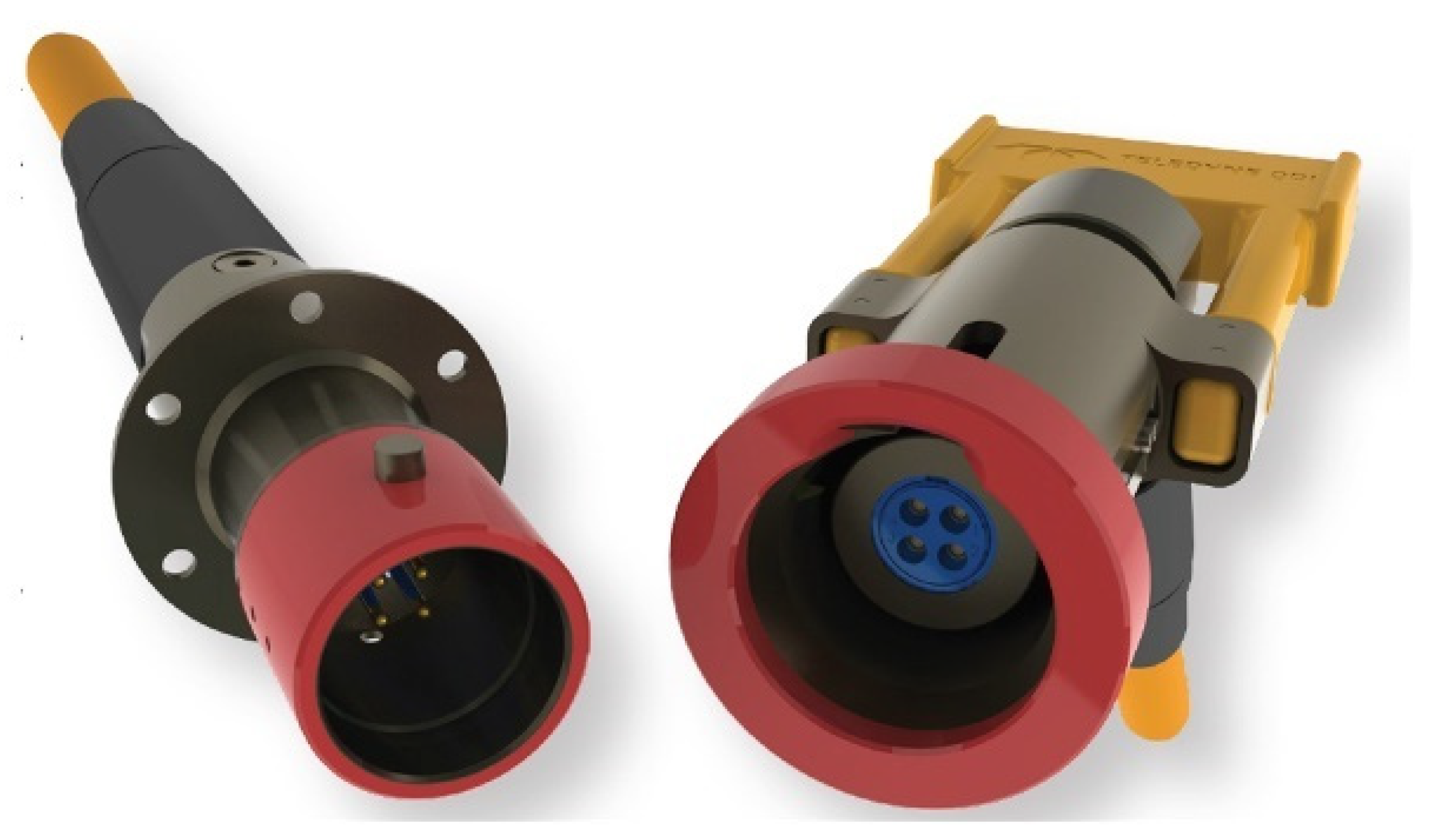
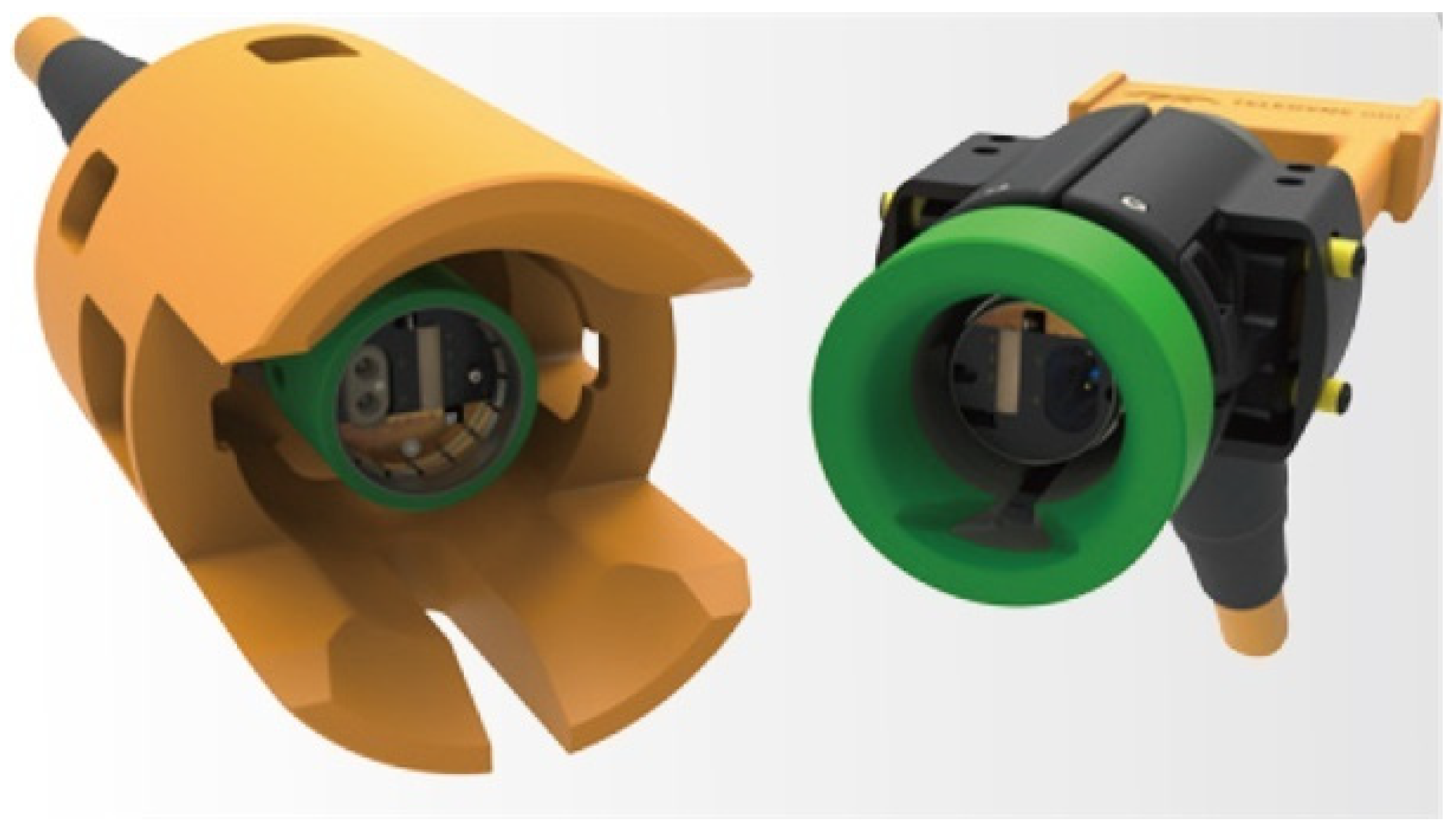

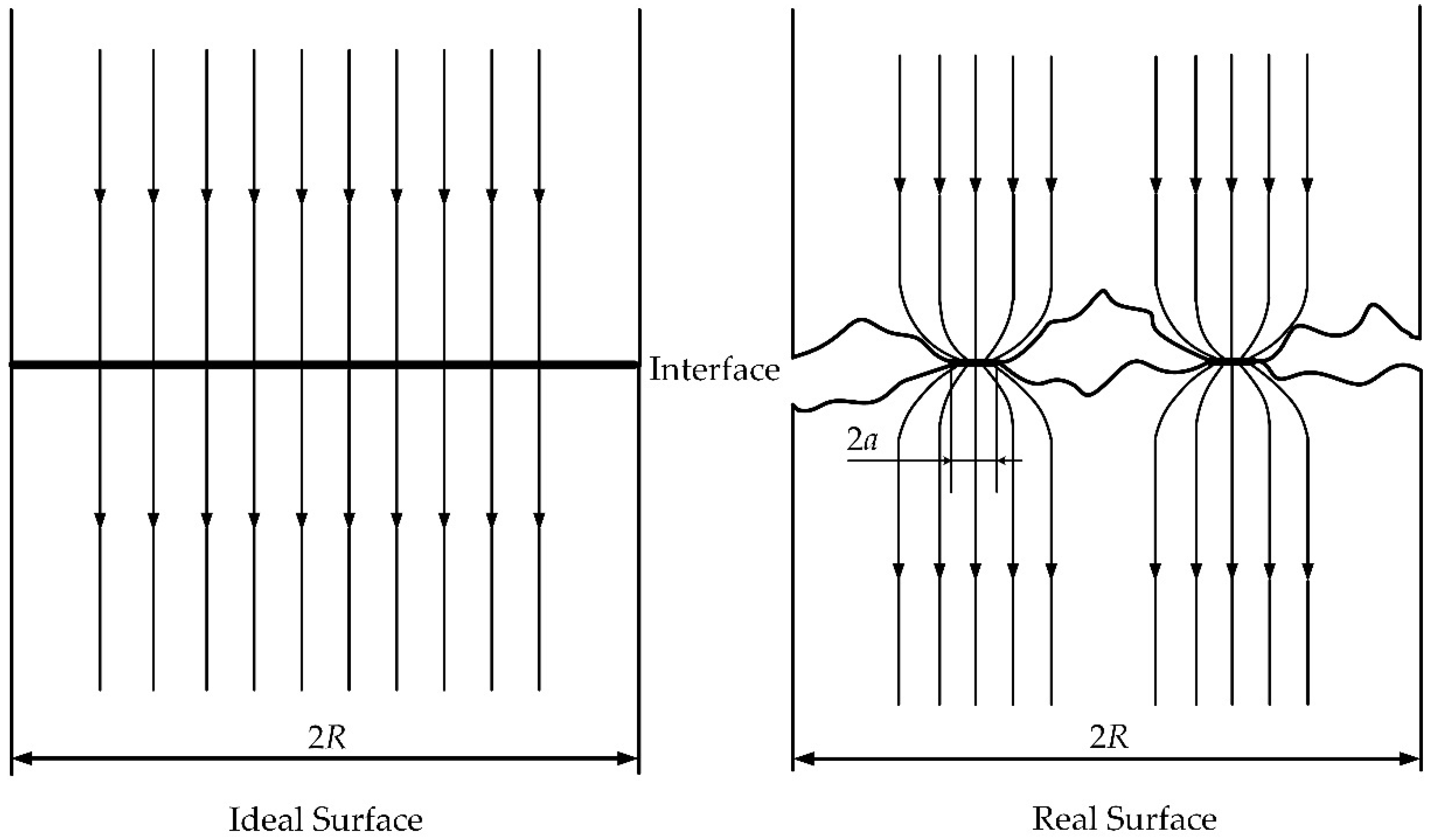

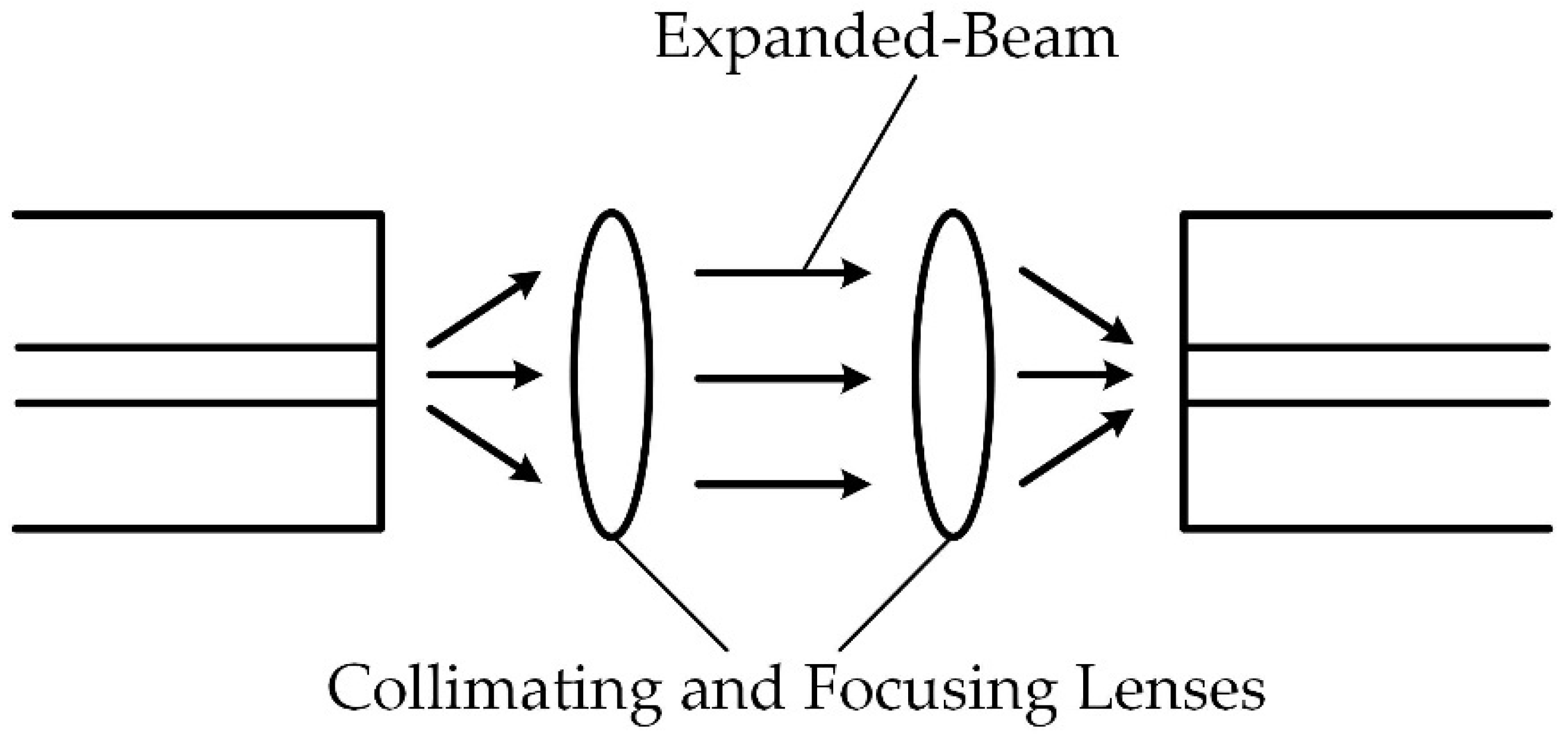

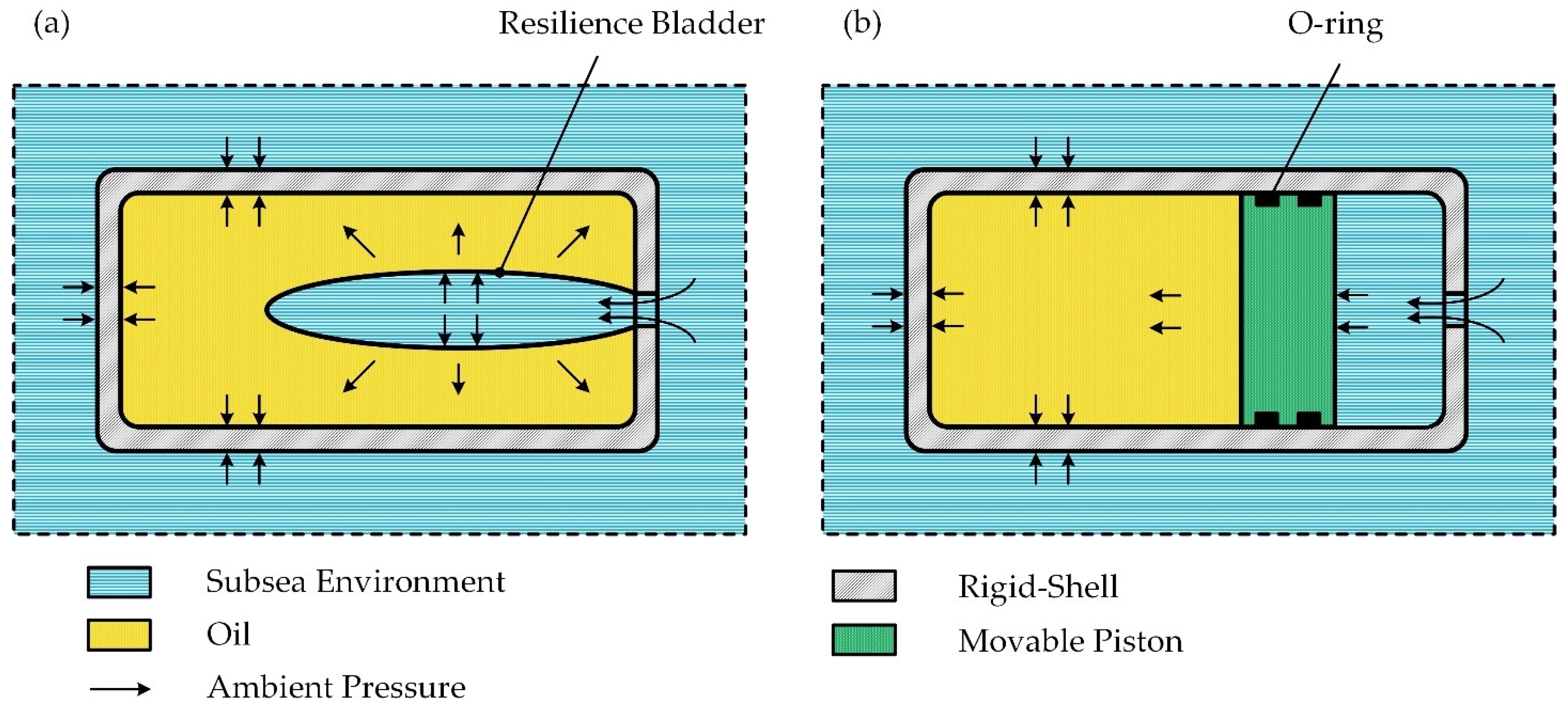
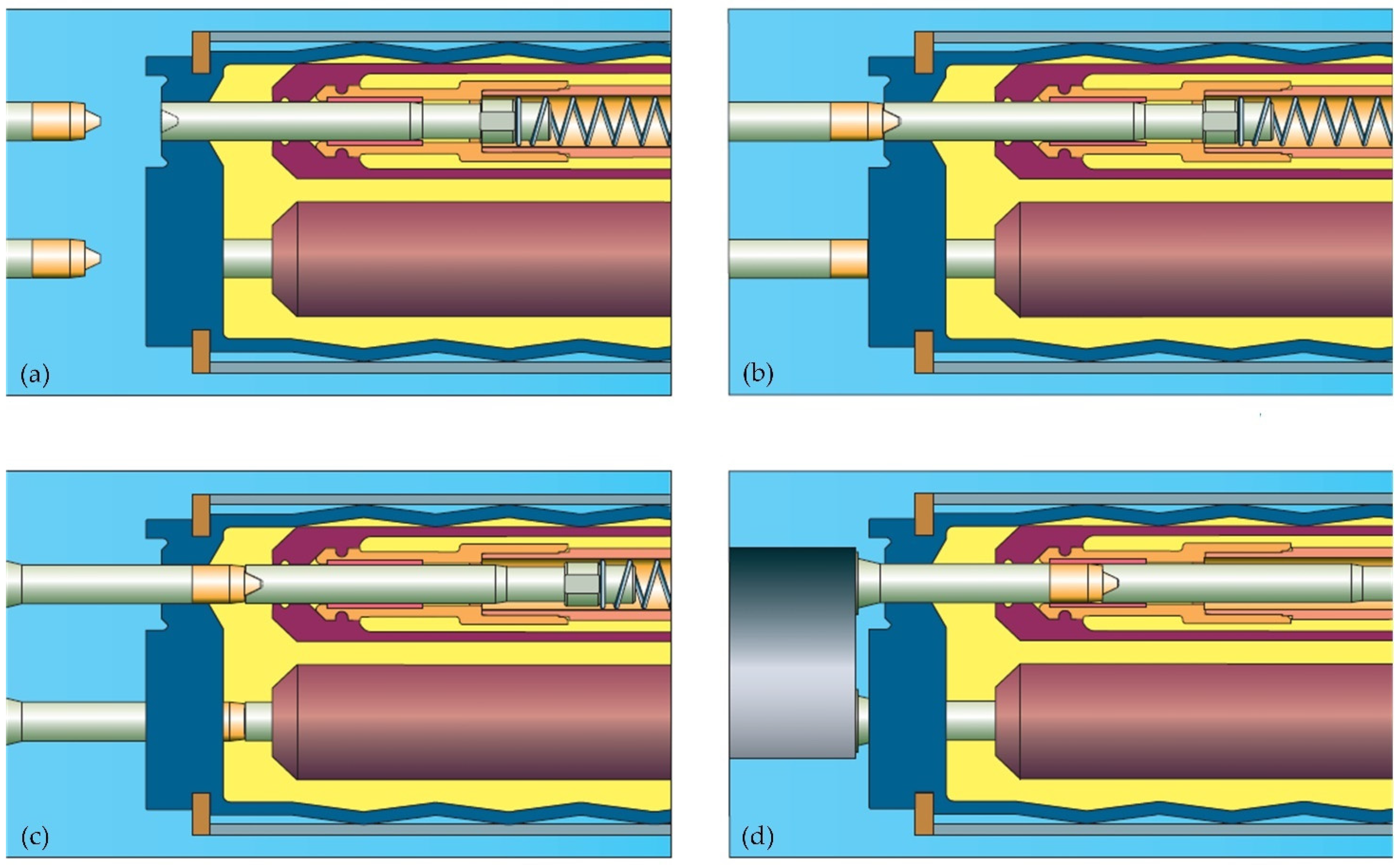


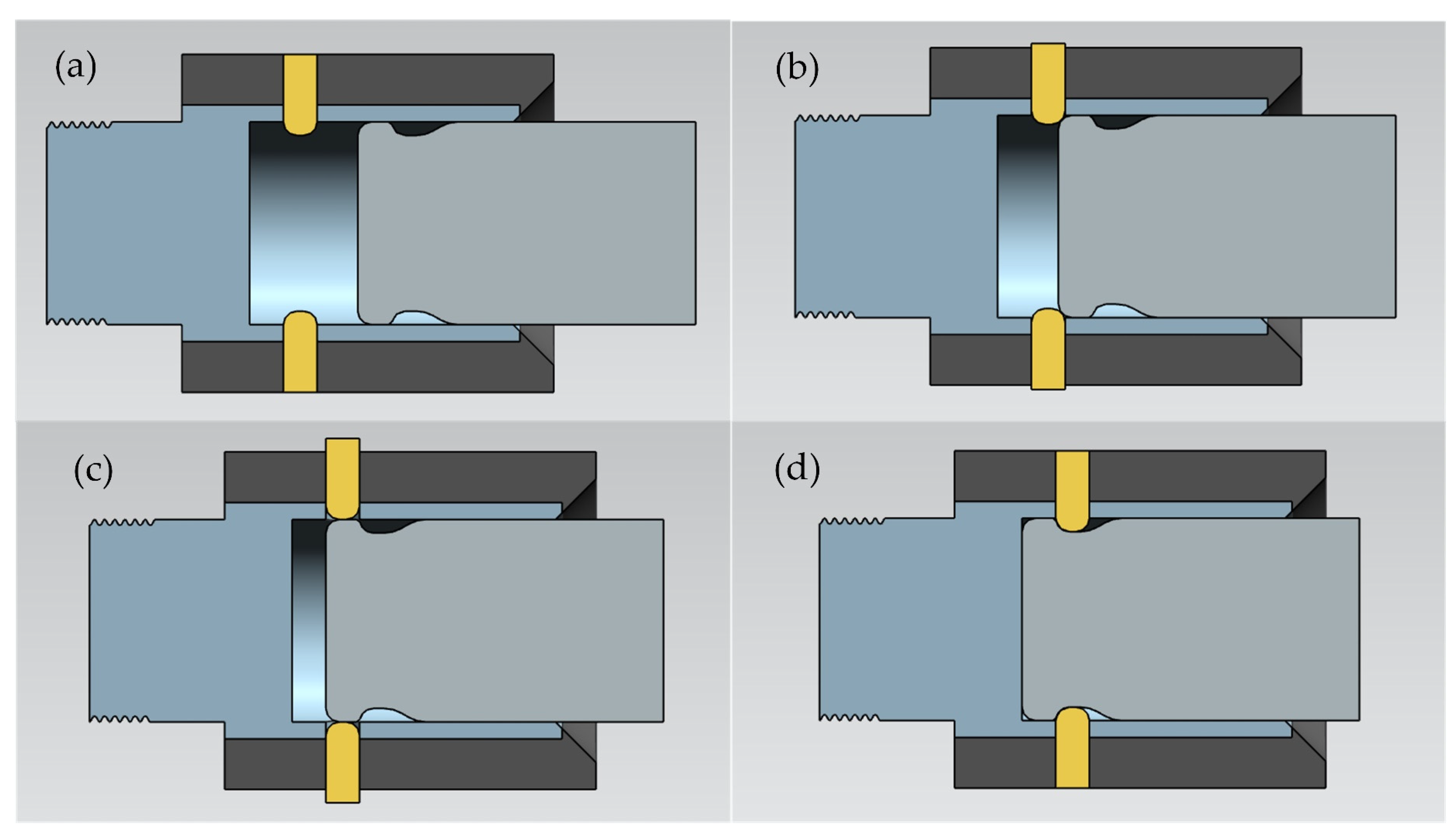


| Brands | Products | Pressure Rates | Contact Resistance | Insulation Resistance | Insertion Loss | Return Loss | Technologies |
|---|---|---|---|---|---|---|---|
| TE’s SEACON | HydraElectric | 4000 m | 0.005 Ω | 20 GΩ | - | - | PBOF and Shuttle Pin |
| HydraLight | 7000 m | - | - | 0.5 dB | 50 dB | UPC and APC | |
| All-Wet | 13,700 m | 0.001 Ω | 500 MΩ | - | - | - | |
| MacArtney | SubConn® Circular | 11,000 m | 0.01 Ω | 200 MΩ | - | - | - |
| OptoLink | 6000 m | - | - | 2.5 dB | 28 dB | Expanded-Beam | |
| Teledyne ODI | NautilusTM | 6400 m | 0.01 Ω | 10 GΩ | - | - | PBOF and Shuttle Pin |
| APC-RSH | - | - | 0.5 dB | 45 dB | APC and Rolling Seal | ||
| NRH | 0.01 Ω | 10 GΩ | 0.5 dB | 45 dB | Hybrid Connector |
Publisher’s Note: MDPI stays neutral with regard to jurisdictional claims in published maps and institutional affiliations. |
© 2021 by the authors. Licensee MDPI, Basel, Switzerland. This article is an open access article distributed under the terms and conditions of the Creative Commons Attribution (CC BY) license (https://creativecommons.org/licenses/by/4.0/).
Share and Cite
Song, W.; Cui, W. An Overview of Underwater Connectors. J. Mar. Sci. Eng. 2021, 9, 813. https://doi.org/10.3390/jmse9080813
Song W, Cui W. An Overview of Underwater Connectors. Journal of Marine Science and Engineering. 2021; 9(8):813. https://doi.org/10.3390/jmse9080813
Chicago/Turabian StyleSong, Wentao, and Weicheng Cui. 2021. "An Overview of Underwater Connectors" Journal of Marine Science and Engineering 9, no. 8: 813. https://doi.org/10.3390/jmse9080813
APA StyleSong, W., & Cui, W. (2021). An Overview of Underwater Connectors. Journal of Marine Science and Engineering, 9(8), 813. https://doi.org/10.3390/jmse9080813






